Estimating Soil Arsenic Content with Visible and Near-Infrared Hyperspectral Reflectance
Abstract
1. Introduction
2. Materials and Methods
2.1. Study Area
2.2. Acquisition and Processing of Soil Data
2.3. Collection and Processing of Soil Spectral Data
2.4. Extraction Feature Bands
2.5. Model Calibration and Validation Methods
2.5.1. Partial Least Squares Regression
2.5.2. Support Vector Regression
2.5.3. Back Propagation Neural Network
2.6. Evaluation Modeling Accuracy
3. Results
3.1. Descriptive Statistics
3.2. Different Resampling Interval Modeling Results
3.3. Different Spectral Preprocessing Method Modeling Results
3.4. Influence of Feature Band Extraction on Segment Modeling Accuracy
3.5. Different Inversion Model Modeling Results
4. Discussion
4.1. Best Inversion Model Analysis
4.2. Inversion Mechanism Analysis
4.3. Limitations and Future Work
5. Conclusions
Author Contributions
Funding
Conflicts of Interest
References
- Herath, I.; Vithanage, M.; Bundschuh, J.; Maity, J.P.; Bhattacharya, P. Natural Arsenic in Global Groundwaters: Distribution and Geochemical Triggers for Mobilization. Curr. Pollut. Rep. 2016, 2, 68–89. [Google Scholar] [CrossRef]
- Holly, M. An arsenic forecast for China. Science 2013, 341, 852–853. [Google Scholar]
- Iva, H. Arsenic in rice: A cause for concern. J. Pediatr. Gastroenterol. Nutr. 2015, 60, 142–154. [Google Scholar]
- Chao, S.; Jiang, J.Q.; Zhang, W.J. A review on heavy metal contamination in the soil worldwide: Situation, impact and remediation techniques. Environ. Skept. Crit. 2014, 3, 24–38. [Google Scholar]
- Guha, M.D.N.; Debasree, D.; Anirban, B.; Chandan, S.; Ashoke, N.; Arabinda, D.; Aloke, G.; Kallol, B.; Kanti, M.K. Dietary arsenic exposure with low level of arsenic in drinking water and biomarker: A study in West Bengal. J. Environ. Sci. Health Part A-Toxic/Hazard. Subst. Environ. Eng. 2014, 49, 555–564. [Google Scholar]
- Sobhanardakani, S. Arsenic health risk assessment through groundwater drinking (case study: Qaleeh shahin agricultural region, kermanshah province, Iran). Pollution 2009, 4, 77–82. [Google Scholar]
- Gong, H.M.; Ma, R.J.; Wang, Z.J.; Ye, Y.; Hu, Y.M. Development of Technologies for Monitoring Agricultural Soil Heavy Metal Pollution. Chin. Agric. Sci. Bull. 2013, 29, 140–147. [Google Scholar]
- Zhu, X.C.; Cao, L.G.; Liang, Y. Spatial distribution and risk assessment of heavy metals inside and outside a typical lead-zinc mine in southeastern China. Environ. Sci. Pollut. Res. 2019, 26, 26265–26275. [Google Scholar] [CrossRef]
- Sørensen, L.K.; Dalsgaard, S. Determination of Clay and Other Soil Properties by Near Infrared Spectroscopy. Soil Sci. Soc. Am. J. 2005, 69, 159. [Google Scholar] [CrossRef]
- Zhang, Q.X.; Zhang, H.B.; Liu, W.K.; Zhao, S.X. Inversion of heavy metals content with hyperspectral reflectance in soil of well-facilitied capital farmland construction areas. Trans. Chin. Soc. Agric. Eng. 2017, 33, 230–239. [Google Scholar]
- Yu, X.; Liu, Q.; Wang, Y.B.; Liu, X.Y.; Liu, X. Evaluation of MLSR and PLSR for estimating soil element contents using visible/near-infrared spectroscopy in apple orchards on the Jiaodong peninsula. Catena 2016, 137, 340–349. [Google Scholar] [CrossRef]
- Zheng, G.H.; Zhou, S.L.; Wu, S.H. Prediction of As in Soil with Reflectance Spectroscopy. Environ. Sci. Pollut. Res. 2011, 31, 173–176. [Google Scholar]
- Cheng, H.; Shen, R.L.; Chen, Y.Y.; Wan, Q.J.; Shi, T.Z.; Wang, J.J.; Wan, Y.; Hong, Y.S.; Li, X.C. Estimating heavy metal concentrations in suburban soils with reflectance spectroscopy. Geoderma 2019, 336, 59–67. [Google Scholar] [CrossRef]
- Ren, H.Y.; Zhuang, D.F.; Qiu, D.S.; Pan, J.Q. Analysis of Visible and Near-Infrared Spectra of As Contaminated Soil in Croplands Beside Mines. Spectrosc. Spectr. Anal. 2009, 29, 114–118. [Google Scholar]
- Wu, Y.Z.; Chen, J.; Ji, J.F.; Gong, P.; Liao, Q.L.; Tian, Q.J.; Ma, H.R. A Mechanism Study of Reflectance Spectroscopy for Investigating Heavy Metals in Soils. Soil Sci. Soc. Am. J. 2007, 71, 918–926. [Google Scholar] [CrossRef]
- Wu, D.W.; Wu, J.Z.; Ma, H.R. Study on the Prediction of Soil Heavy Metal Elements Content Based on Mid-Infrared Diffuse Reflectance Spectra. Spectrosc. Spectr. Anal. 2010, 30, 1498–1502. [Google Scholar]
- Zhang, W.; Gao, X.H.; Yang, Y.; Li, J.S.; Zhang, Y.J.; Tian, C.M.; Jia, W.; Feng, L.; Ma, Y.L.; Yuan, H.X.; et al. Estimating Heavy Metal Contents for Topsoil Based on Spectral Analysis —A Case Study of Yushu and Maduo Counties in the Three-River Source Region. Soils 2014, 46, 1052–1060. [Google Scholar]
- Wang, J.J.; Cui, L.J.; Gao, W.X.; Shi, T.Z.; Chen, Y.Y.; Gao, Y. Prediction of low heavy metal concentrations in agricultural soils using visible and near-infrared reflectance spectroscopy. Geoderma 2014, 216, 1–9. [Google Scholar] [CrossRef]
- Liu, P.; Liu, Z.H.; Hu, Y.M.; Shi, Z.; Pan, Y.C.; Wang, L.; Wang, G.X. Integrating a Hybrid Back Propagation Neural Network and Particle Swarm Optimization for Estimating Soil Heavy Metal Contents Using Hyperspectral Data. Sustainability 2019, 11, 419. [Google Scholar] [CrossRef]
- Xu, L.J.; Li, Q.Q.; Zhu, X.M.; Liu, S.G. Hyperspectral Inversion of Heavy Metal Content in Coal Gangue Filling Reclamation Land. Spectrosc. Spectr. Anal. 2017, 37, 3839–3844. [Google Scholar]
- Tan, K.; Ye, Y.Y.; Du, P.J.; Zhang, Q.Q. Estimation of Heavy Metal Concentrations in Reclaimed Mining Soils Using Reflectance Spectroscopy. Spectrosc. Spectr. Anal. 2014, 34, 3317–3322. [Google Scholar]
- Mutanga, O.; Skidmore, A.K.; Prins, H.H.T. Predicting in situ pasture quality in the Kruger National Park, South Africa, using continuum-removed absorption features. Remote Sens. Environ. 2003, 89, 393–408. [Google Scholar] [CrossRef]
- Zhao, L.; Hu, Y.M.; Zhou, W.; Liu, Z.H.; Pan, Y.C.; Shi, Z.; Wang, L.; Wang, G.X. Estimation Methods for Soil Mercury Content Using Hyperspectral Remote Sensing. Sustainability 2018, 10, 2474. [Google Scholar] [CrossRef]
- Curran, P.J.; Dungan, J.L.; Peterson, D.L. Estimating the foliar biochemical concentration of leaves with reflectance spectrometry. Remote Sens. Environ. 2001, 76, 349–359. [Google Scholar] [CrossRef]
- Fukunaga, K.; Koontz, W.L.G. Representation of random processes using the finite Karhunen-Loève expansion. Inf. Control 1970, 16, 85–101. [Google Scholar] [CrossRef]
- Wang, H.W. Partial Least Squares Regression Method and its Application; National Defense Industry Press: Beijing, China, 1999; pp. 1–3. [Google Scholar]
- Hsu, C.; Lin, C. A comparison of methods for multiclass support vector machines. IEEE Trans. Neural Netw. 2008, 13, 415–425. [Google Scholar]
- Liu, X.B. Analysis and Research of Forecast Model on PM2.5 Using Support Vector Regression. Master’s Thesis, Southwestern University Of Finance And Economics, Chengdu, China, 2016. [Google Scholar]
- Lian, C.Y. Support Vector Regression Based on Genetic Algorithm and its Application in Phase Separation Procedure with Salts. Master’s Thesis, Hebei University Of Technology, Wuhan, China, 2015. [Google Scholar]
- Zhou, Z.H. Neural Network and its Application; Tsinghua University Press: Beijing, China, 2004. [Google Scholar]
- Esbensen, K.H.; Guyot, D.; Westad, F.; Lars, P.H. Multivariate Data Analysis: An Introduction to Multivariate Data Analysis and Experimental Design, 5th ed.; CAMO Software: Oslo, Norway, 2002; p. 598. [Google Scholar]
- Si, H.Q.; Yao, Y.M.; Qang, D.Y.; Liu, Y. Hyperspectral prediction of soil organic matter contents under different soil moisture contents. Trans. Chin. Soc. Agric. Eng. 2015, 31, 114–120. [Google Scholar]
- GB 15618-2018. Soil Environmental Quality—Risk Control Standard for Soil Contamination of Agricultural Land; Ministry of Ecology and Environment of the People’s Republic of China: Beijing, China, 2018. Available online: http://www.mee.gov.cn/ywgz/fgbz/bz/bzwb/trhj/201807/t20180703_446029.shtml. (accessed on 2 November 2019).
- GB 36600-2018. Soil Environmental Quality—Risk Control Standard for Soil Contamination of a Development Land; Ministry of Ecology and Environment of the People’s Republic of China: Beijing, China, 2018. Available online: http://www.mee.gov.cn/ywgz/fgbz/bz/bzwb/trhj/ (accessed on 3 November 2019).
- Wu, Y.Z.; Chen, J.; Wu, X.M.; Tian, Q.J.; Ji, J.F.; Qin, Z.H. Possibilities of reflectance spectroscopy for the assessment of contaminant elements in suburban soils. Appl. Geochem. 2005, 20, 0–1059. [Google Scholar] [CrossRef]
- Nayak, P.S.; Singh, B.K. Instrumental characterization of clay by XRF, XRD and FTIR. Bull. Mat. Sci. 2007, 30, 235–238. [Google Scholar] [CrossRef]
- Ben-Dor, E.; Inbar, Y.; Chen, Y. The reflectance spectra of organic matter in the visible near-infrared and short wave infrared region (400–2500 nm) during a controlled decomposition process. Remote Sens. Environ. 1997, 61, 1–15. [Google Scholar] [CrossRef]
- Thomas, K.; Stefan, S. Estimate of heavy metal contamination in soils after a mining accident using reflectance spectroscopy. Environ. Sci. Technol. 2002, 36, 2742–2747. [Google Scholar]
- Song, l.; Jian, J.; Tan, D.J.; Xie, H.B.; Luo, Z.F.; Gao, B. Estimation of soil’s heavy metal concentration (As, Cd and Zn) in Wansheng mining area with geochemistry and field spectroscopy. Spectrosc. Spectr. Anal. 2014, 34, 812–817. [Google Scholar]
- Zhao, F.J.; McGrath, S.P.; Meharg, A.A. Arsenic as a food chain contaminant: Mechanisms of plant uptake and metabolism and mitigation strategies. Annu. Rev. Plant Biol. 2010, 61, 535–559. [Google Scholar] [CrossRef] [PubMed]
- Gao, P.; Fu, T.G.; Wang, K.L.; Chen, H.Y.; Zeng, F.P. Spatial heterogeneity of surface soil mineral components in a small catchment in Karst peakcluster depression area, South China. Chin. J. Appl. Ecol. 2013, 24, 3179–3184. [Google Scholar]
- Liu, H.J.; Wang, X.; Li, H.X.; Meng, X.T.; Jiang, B.W.; Zhang, X.L.; Yu, Z.Y. Effect mechanism of soil minerals on spectral characteristics of main soil classes in songnen plain. Spectrosc. Spectr. Anal. 2018, 38, 3238–3244. [Google Scholar]
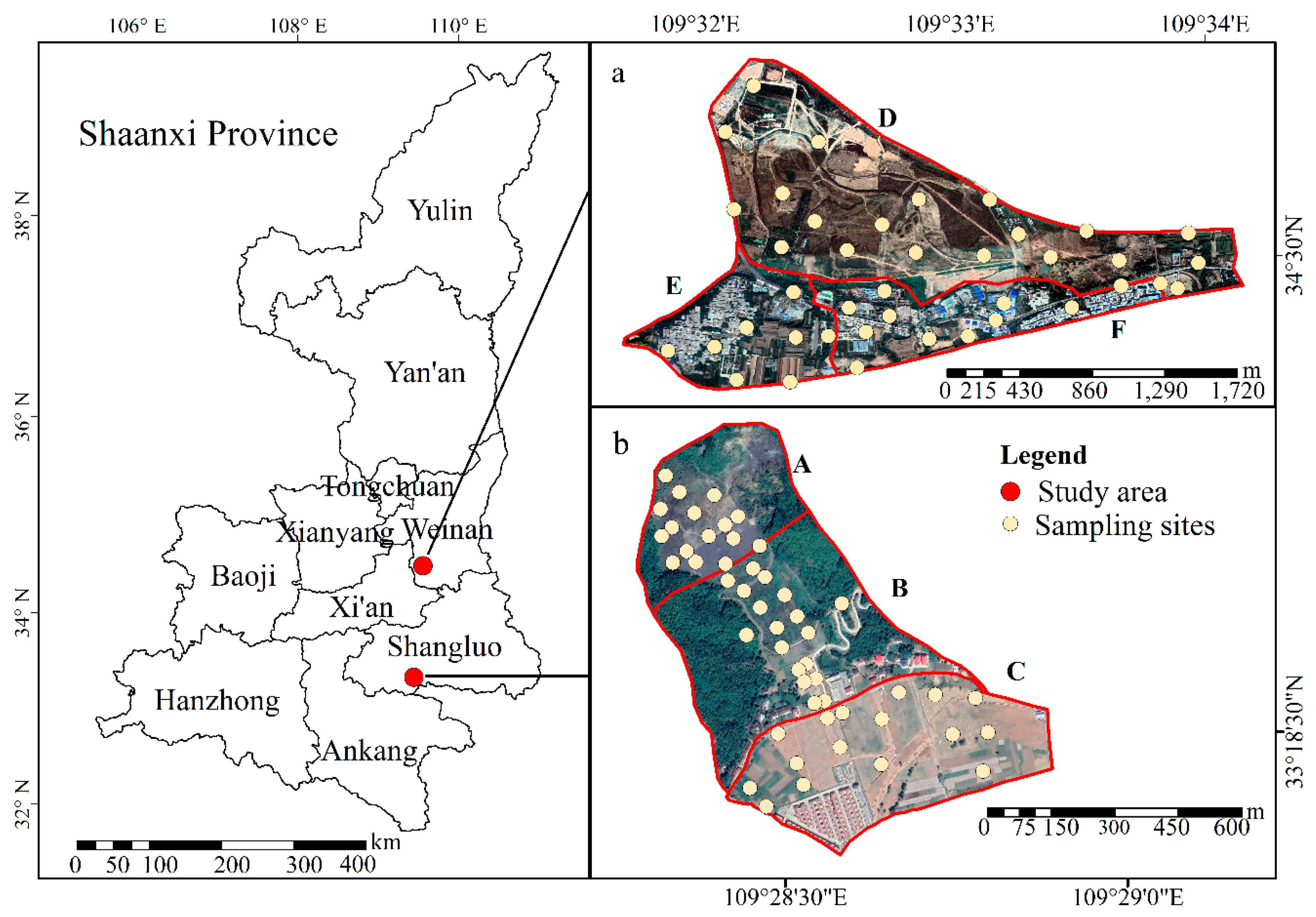

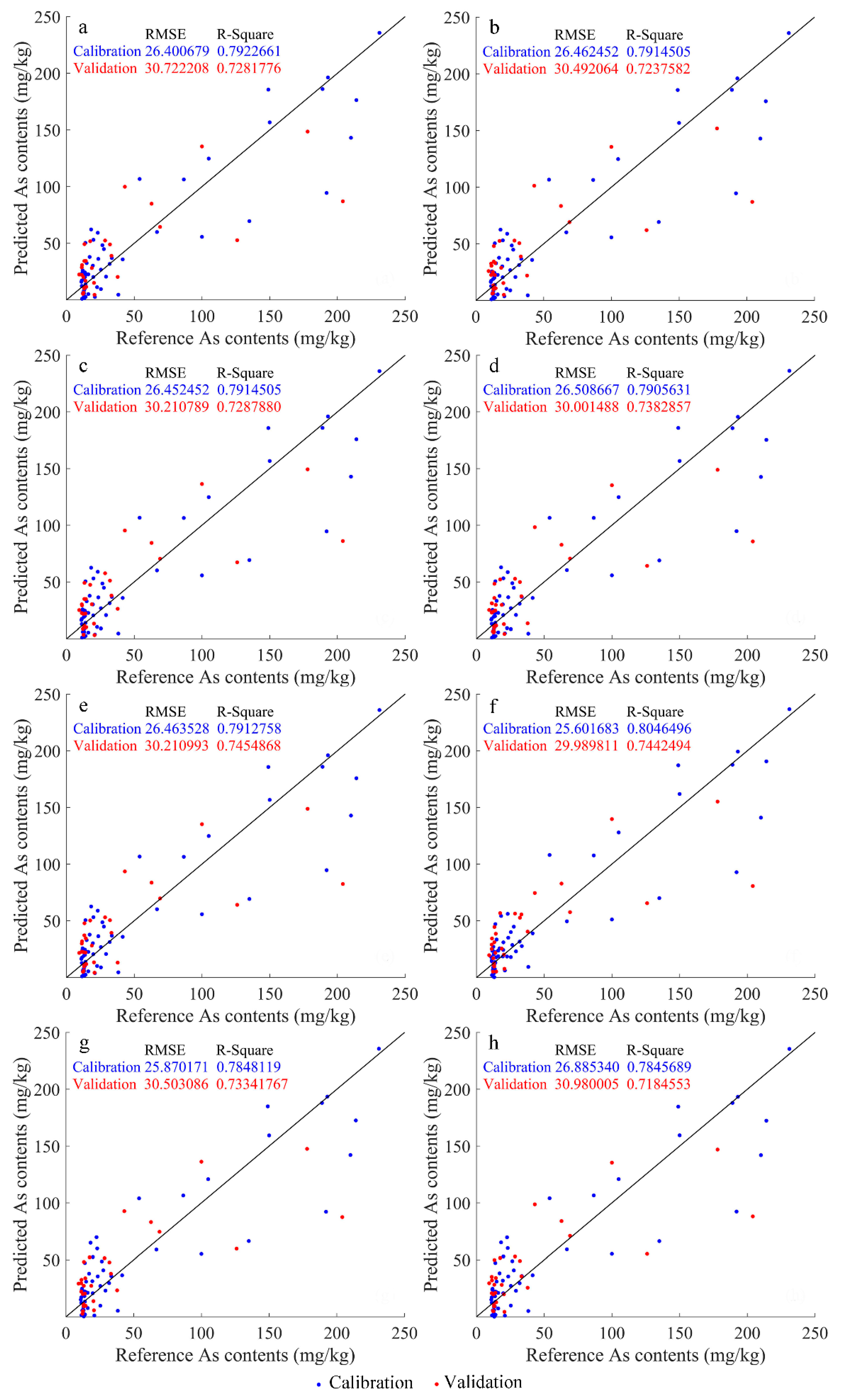
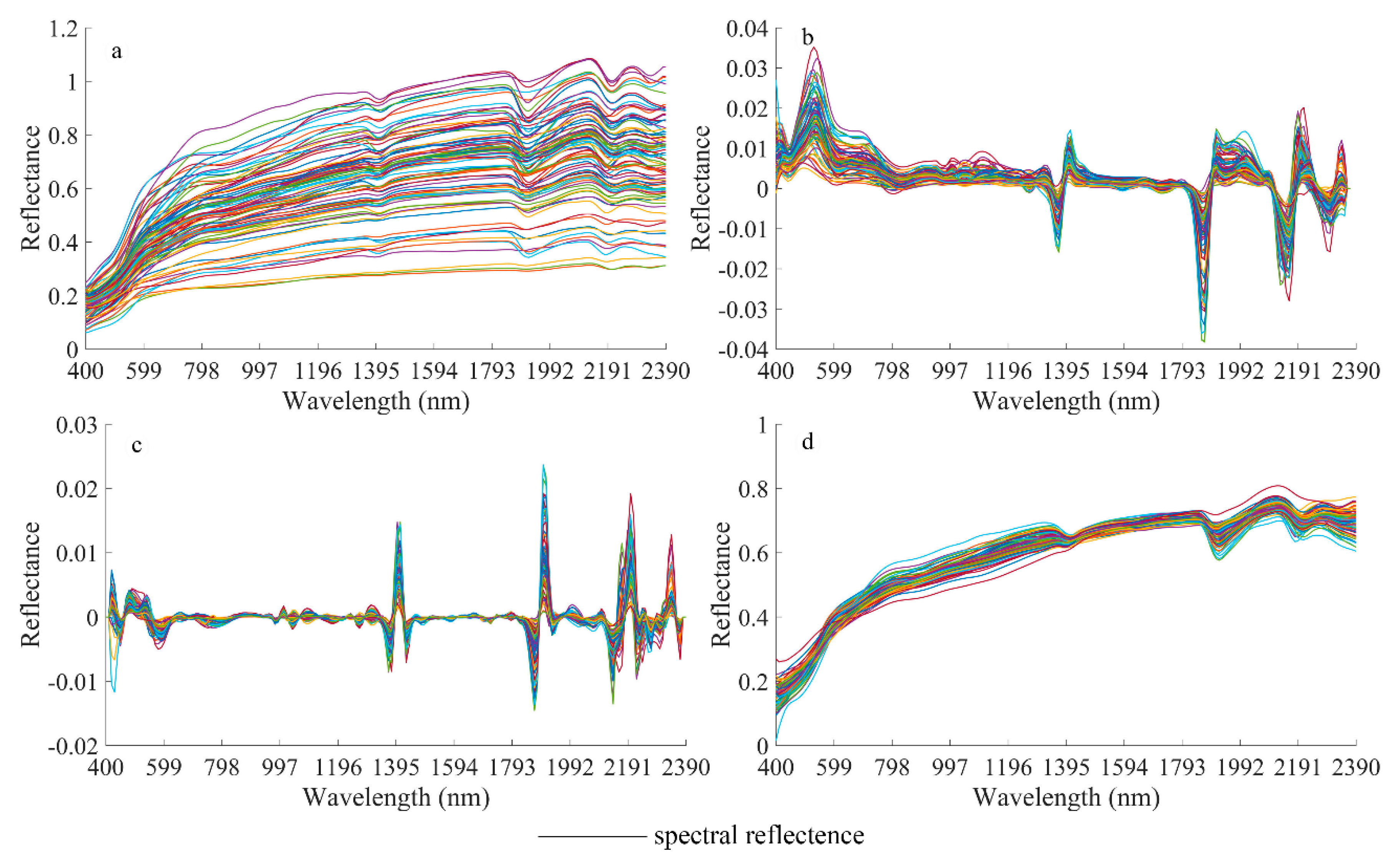


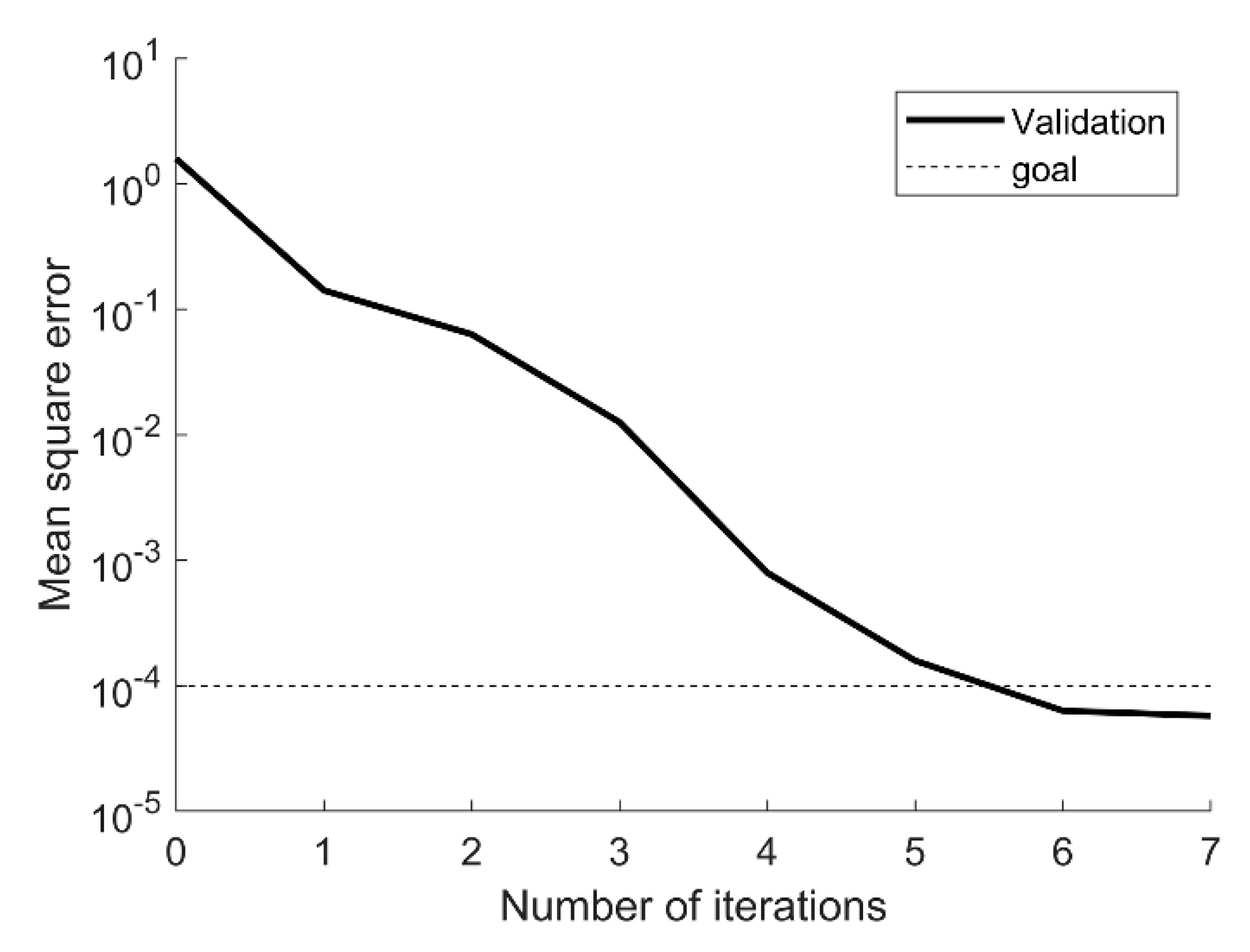

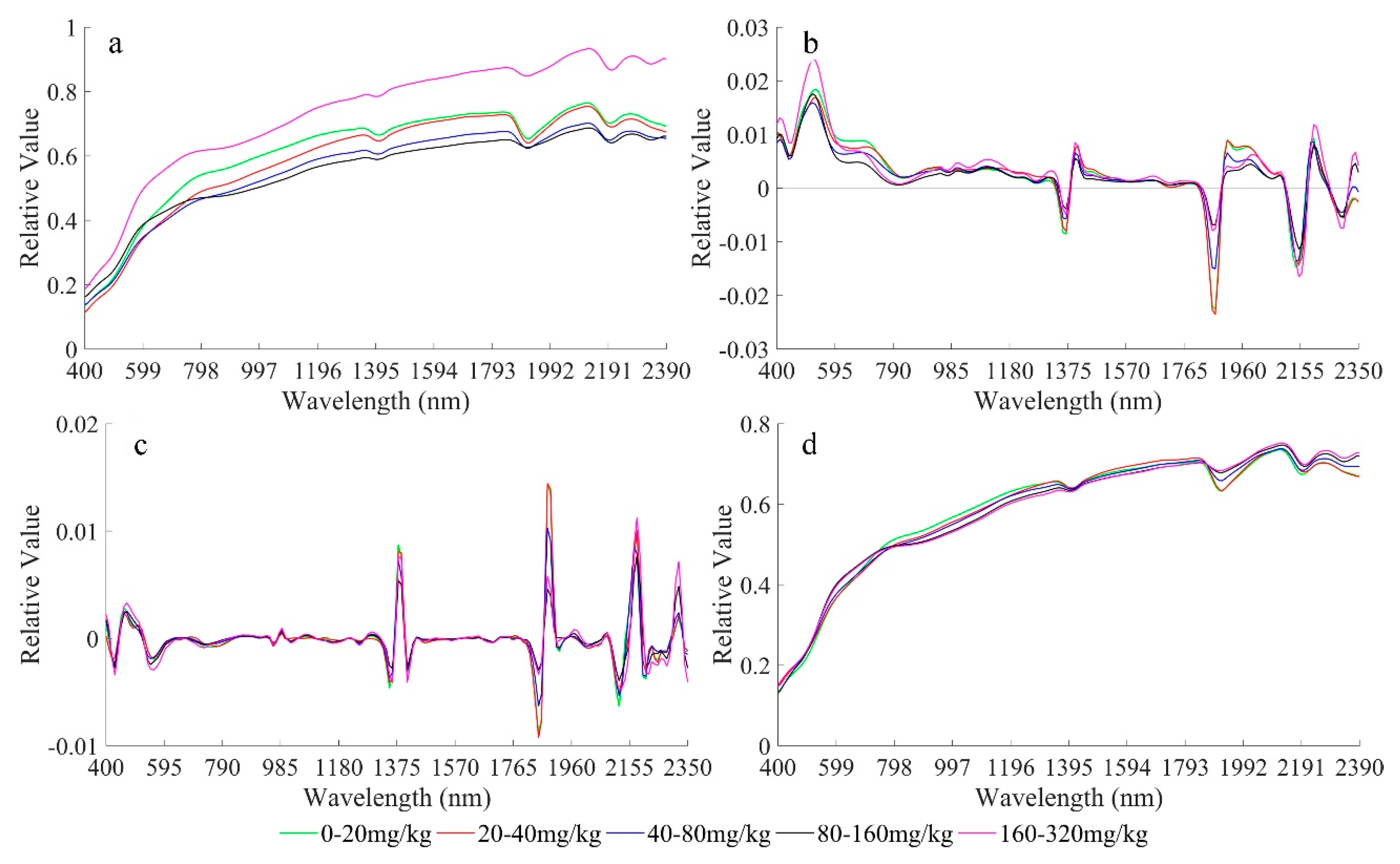
| Site Type | Item | Max | Min | Mean | Coefficient of Variation | Background Value | Ratio | |
|---|---|---|---|---|---|---|---|---|
| Mining Area | A | AS (mg/kg) | 231.00 | 54.00 | 150.70 | 0.37 ** | 60 | 2.51 |
| pH | 8.93 | 8.04 | 8.37 | |||||
| B | AS (mg/kg) | 100.00 | 13.30 | 35.21 | 0.71 ** | 25 | 1.41 | |
| pH | 8.56 | 5.33 | 8.19 | |||||
| C | AS (mg/kg) | 41.50 | 16.10 | 25.88 | 0.28 ** | 25 | 1.03 | |
| pH | 8.40 | 7.53 | 8.13 | |||||
| Suburb | D | AS (mg/kg) | 14.30 | 11.30 | 12.58 | 0.07 | 60 | 0.21 |
| pH | 9.13 | 8.40 | 8.81 | |||||
| E | AS (mg/kg) | 16.10 | 12.20 | 13.55 | 0.08 ** | 20 | 0.68 | |
| pH | 8.88 | 8.18 | 8.52 | |||||
| F | AS (mg/kg) | 14.90 | 9.40 | 12.53 | 0.12 * | 60 | 0.21 | |
| pH | 8.74 | 8.28 | 8.47 | |||||
| Data Set | Max (mg/kg) | Min (mg/kg) | Mean (mg/kg) | Coefficient of Variation |
|---|---|---|---|---|
| Calibration Set | 231.00 | 9.40 | 45.61 | 1.28 ** |
| Validation Set | 214.00 | 11.00 | 45.01 | 1.27 ** |
| k | RMSEC | RMSEV | MAEC | MAEV | RPD | |||
|---|---|---|---|---|---|---|---|---|
| Original | 5 | 26.40 | 30.72 | 0.7923 | 0.7282 | 16.9763 | 22.6354 | 1.6546 |
| 2 nm | 4 | 26.52 | 30.49 | 0.7915 | 0.7238 | 16.8406 | 22.2215 | 1.6655 |
| 4 nm | 3 | 26.45 | 30.21 | 0.7915 | 0.7288 | 16.5236 | 21.6547 | 1.6989 |
| 6 nm | 3 | 26.51 | 30.00 | 0.7906 | 0.7383 | 15.4459 | 21.3645 | 1.6922 |
| 8 nm | 3 | 26.46 | 30.21 | 0.7913 | 0.7455 | 15.4321 | 22.2156 | 1.6592 |
| 10 nm | 3 | 25.60 | 29.99 | 0.8046 | 0.7442 | 15.3981 | 20.5442 | 1.7253 |
| 12 nm | 3 | 26.37 | 30.50 | 0.7848 | 0.7334 | 16.2564 | 21.1965 | 1.6543 |
| 14 nm | 3 | 26.89 | 30.98 | 0.7846 | 0.7185 | 17.3365 | 22.0398 | 1.6312 |
| k | RMSEC | RMSEV | MAEC | MAEV | RPD | |||
|---|---|---|---|---|---|---|---|---|
| Original | 3 | 25.60 | 29.99 | 0.8046 | 0.7443 | 15.3981 | 20.5442 | 1.7253 |
| S–G | 3 | 25.68 | 28.01 | 0.8034 | 0.7661 | 15.4988 | 21.3561 | 1.8576 |
| FD | 4 | 26.04 | 28.20 | 0.7980 | 0.7579 | 15.8322 | 20.5414 | 1.8375 |
| SD | 4 | 24.90 | 27.77 | 0.8152 | 0.7701 | 16.8899 | 14.6293 | 1.8874 |
| MSC | 3 | 29.71 | 32.24 | 0.7369 | 0.6892 | 19.9307 | 20.5229 | 1.5499 |
| Principal Component | PC1 | PC2 | PC3 | PC4 | PC5 | PC6 | PC7 | PC8 | PC9 | PC10 |
|---|---|---|---|---|---|---|---|---|---|---|
| Cumulative (%) | 53.6 | 72.8 | 85.8 | 92.5 | 94.1 | 95.6 | 96.6 | 97.3 | 97.8 | 98.2 |
| Soil Properties | Feature Bands/nm |
|---|---|
| AS | 430, 450, 470, 480, 530, 610, 620, 640–660, 1030–1060, 1080–1110, 1230, 1240, 1280, 1300–1320, 1360–1380, 1400, 1400, 1480, 1510, 1580, 1750, 1850–1930, 2050, 2120, 2140, 2160, 2170, 2190–2220, 2250, 2340–2360 |
| k | RMSEC | RMSEV | MAEC | MAEV | RPD | |||
|---|---|---|---|---|---|---|---|---|
| Feature Bands | 2 | 26.86 | 29.62 | 0.7850 | 0.7384 | 22.1084 | 24.5437 | 1.7389 |
| All-bands | 4 | 24.90 | 27.77 | 0.8152 | 0.7701 | 14.6293 | 16.8899 | 1.8874 |
| RMSEC | RMSEV | MAEC | MAEV | RPD | |||
|---|---|---|---|---|---|---|---|
| PLSR | 24.90 | 27.77 | 0.8152 | 0.7701 | 14.6293 | 16.8899 | 1.8874 |
| SVR | 32.80 | 34.17 | 0.7570 | 0.7201 | 16.6159 | 20.3121 | 1.0313 |
| BPNN | 16.59 | 20.29 | 0.9322 | 0.8607 | 11.2749 | 14.4226 | 2.5362 |
| Sampling Site | Num. | Methods | R2 | RPD | References |
|---|---|---|---|---|---|
| Agricultural Soils | 33 | MSC + PCR | 0.3674 | [14] | |
| Suburban Area | 61 | FD + PLSR | 0.7200 | 1.9000 | [15] |
| Suburban Area | 93 | SG + PLSR | 0.7500 | 1.8100 | [13] |
| Urban Area | 161 | SG + PLSR | 0.6700 | 1.7200 | [16] |
| Urban Area | 97 | 4nm + MSC + PLSR | 0.7110 | 1.8270 | [12] |
| Urban Area | 154 | BD + MLR | 0.3900 | 1.2300 | [17] |
| Urban Area | 96 | GA + PLSR | 0.3500 | 1.0900 | [18] |
| Urban Area | 90 | PSO + BPNN | 0.8110 | [19] | |
| Mining Area | 45 | SD + PLSR | 0.8400 | [20] | |
| Mining and Suburban Areas | 90 | 10nm + SD + BPNN | 0.8607 | 2.5362 | This work |
| AS Content | Number of Sample | RMSEC | RMSEV | MAEC | MAEV | RPD | ||
|---|---|---|---|---|---|---|---|---|
| 0–20 mg/kg | 52 | 13.31 | 16.52 | 0.9254 | 0.8736 | 11.5896 | 13.6354 | 2.825 |
| 20–40 mg/kg | 18 | 15.49 | 18.86 | 0.9109 | 0.8689 | 11.8614 | 14.2145 | 2.757 |
| 40–80 mg/kg | 6 | 19.18 | 21.90 | 0.9852 | 0.8496 | 12.2016 | 14.249 | 2.365 |
| 80–160 mg/kg | 8 | 19.34 | 23.63 | 0.8761 | 0.8599 | 12.0254 | 13.9965 | 2.412 |
| 160–320 mg/kg | 8 | 17.09 | 21.36 | 0.8815 | 0.8606 | 12.6321 | 14.6254 | 2.613 |
© 2020 by the authors. Licensee MDPI, Basel, Switzerland. This article is an open access article distributed under the terms and conditions of the Creative Commons Attribution (CC BY) license (http://creativecommons.org/licenses/by/4.0/).
Share and Cite
Han, L.; Chen, R.; Zhu, H.; Zhao, Y.; Liu, Z.; Huo, H. Estimating Soil Arsenic Content with Visible and Near-Infrared Hyperspectral Reflectance. Sustainability 2020, 12, 1476. https://doi.org/10.3390/su12041476
Han L, Chen R, Zhu H, Zhao Y, Liu Z, Huo H. Estimating Soil Arsenic Content with Visible and Near-Infrared Hyperspectral Reflectance. Sustainability. 2020; 12(4):1476. https://doi.org/10.3390/su12041476
Chicago/Turabian StyleHan, Lei, Rui Chen, Huili Zhu, Yonghua Zhao, Zhao Liu, and Hong Huo. 2020. "Estimating Soil Arsenic Content with Visible and Near-Infrared Hyperspectral Reflectance" Sustainability 12, no. 4: 1476. https://doi.org/10.3390/su12041476
APA StyleHan, L., Chen, R., Zhu, H., Zhao, Y., Liu, Z., & Huo, H. (2020). Estimating Soil Arsenic Content with Visible and Near-Infrared Hyperspectral Reflectance. Sustainability, 12(4), 1476. https://doi.org/10.3390/su12041476






